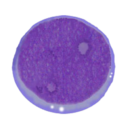Recognition of APL differentiation: Difference between revisions
From haematologyetc.co.uk
(Created page with " <div id="AML_AplPic">'''Recognition of acute promyelocytic leukaemia'''</div> 130px <span style="font-size:90%">Typical APL has cells that are hypergranular (A) or may be the microgranular variant (B) generally the cells will have a range of granulation or nuclear appearance. While CD45 expression tends to be weak, in almost all cases the variable morphological features cause a wide range of side-scatter with the abnormal cells often forming a...") |
No edit summary |
||
| Line 1: | Line 1: | ||
---- | |||
<div style="width: 200px"> | |||
{| class="wikitable" style="border-left:solid 5px green;border-right:solid 5px green;border-top:solid 5px black;border-bottom:solid 5px black; font-size:90%; color:navy" | |||
| colspan="1"''|[[Atypical patterns of primitive marker expression in acute myeloid leukaemia|Return to previous page]]'' | |||
|} | |||
</div> | |||
---- | |||
< | |||
<span style="font-size:90%">'''Recognition of acute promyelocytic leukaemia'''</span> | |||
[[Image:AML M1.png|130px]] | [[Image:AML M1.png|130px]] | ||
Latest revision as of 00:15, 12 January 2024
Recognition of acute promyelocytic leukaemia
Typical APL has cells that are hypergranular (A) or may be the microgranular variant (B) generally the cells will have a range of granulation or nuclear appearance. While CD45 expression tends to be weak, in almost all cases the variable morphological features cause a wide range of side-scatter with the abnormal cells often forming a "cloud" extending toward the neutrophil area. This can make the cells (particular hypergranular forms) difficult to distinguish from reactive myeloid populations (or occasionally from MDS). Absent HLA-DR on APL cells can help distinguish from reactive cells (expressing HLA-DR), but correlation with morphology and clinical features and other confirmatory tests are essential to the recognition of APL.
